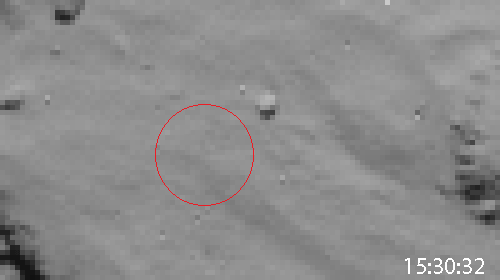This article is more than 1 year old
Lights OUT for Philae BUT slumbering probot could phone home again as comet nears Sun
Energy-zapped boffins celebrate incredible mission
Philae's final hurrah (for now at least) on Comet 67P/Churyumov-Gerasimenko ended with success, the mission's jubilant boffins confirmed late last night.
The fridge-sized, plucky probot, which made the historic landing on the speeding, icy space-rock 300 million miles (or 500 million kilometres) from Earth on Wednesday, was drained of the last of its battery power in the early hours of Saturday morning.
But that was only after Philae was able to return all of its housekeeping and science data to its Rosetta mothership, which then beamed the information back to mission control in Darmstadt, Germany.
As the lander's energy was increasingly being zapped, it continued to work through its various tasks feeding key measurement information from the targeted instruments, such as ROLIS, COSAC, Ptolemy, SD2 and CONSERT.
Boldly and audaciously, Philae's boffins were able to push the probot up about 4 centimetres, before performing a 35 degree rotation in the hope of basking it in more sunlight.
The craft is loaded with solar panels, which could bring Philae back into action at a later point as the comet nears our Sun, so the manoeuvre was critical in terms of attempting to extend the lander's incredible, cosmic-rock adventure.
Boffins remain perplexed about the probot's final landing site. They are working hard to try to locate Philae's exact position. Meanwhile, Rosetta has moved back into a 30 kilometre orbit around the comet. It will return for a closer encounter with 67P on 6 December.
DLR German Aerospace Agency lander boss Stephan Ulamec said:
It has been a huge success, the whole team is delighted. Despite the unplanned series of three touchdowns, all of our instruments could be operated and now it’s time to see what we’ve got.
We still hope that at a later stage of the mission, perhaps when we are nearer to the Sun, that we might have enough solar illumination to wake up the lander and re-establish communication.

Philae's first touchdown seen by Rosetta's NavCam. Image credit: ESA/Rosetta/NavCam
Images from Philae's descent to the comet showed that it was covered by dust and debris, while panoramic snaps revealed "layered walls of harder-looking material."
Scientists are now searching the data to see if any of 67P's material has been sampled with Philae's drill.
"At the end of this amazing rollercoaster week, we look back on a successful first-ever soft-landing on a comet," said European Space Agency's Rosetta mission manager Fred Jansen.
"This was a truly historic moment for ESA and its partners. We now look forward to many more months of exciting Rosetta science and possibly a return of Philae from hibernation at some point in time.” ®
